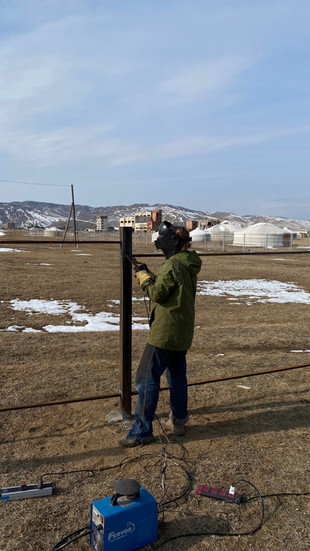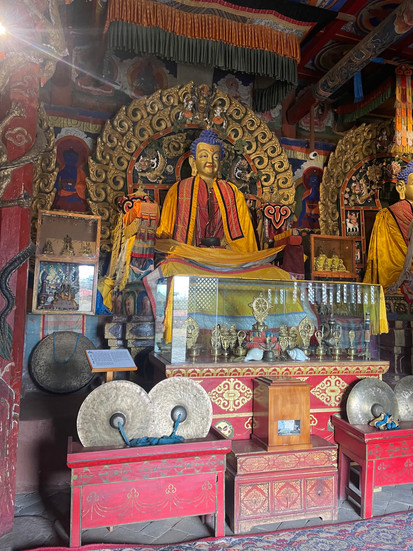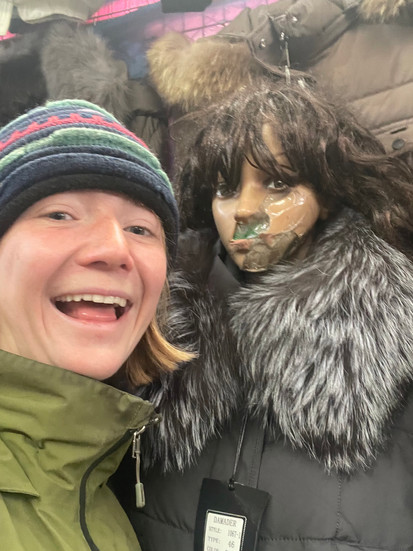Buddhism, Racism, and the Calligrapher
- stemeillon
- Nov 2, 2024
- 10 min read
In this post I will talk about my scattered last couple of weeks in Mongolia, where I lived and worked for a master calligrapher and his family. My time there helped to confuse my interpretation of Mongolian culture and gave me more perspective on their way of thought, while also getting to know the family and the Buddhist side of Mongolia. I had a glimpse of the brutality of winter here, and spent my last days in Mongolia in the capital city of Ulaanbaatar.
Also! I made a Spotify playlist with songs I heard while I was here if you are curious about Mongolian music.
Chez the Calligrapher
After traveling to the west of Mongolia, I made my way to the ancient capital to work for a Mongolian calligrapher and his Polish wife, Agata. Tamir subscribes to Buddhist beliefs, as does roughly 60% of Mongolia, and he was quick to share them with us. It was an eye-opening conversation; it really felt like I was sitting in front of an all-knowing monk. He told us how he evaded death after two days in an unlikely coma. He spoke about the concept of imprisonment and how, when you escape your mind, you can start living instead of merely existing. That emotion is a color of thought. He described love as an illusion, stating that if you are thinking about love, you are not truly experiencing it. To really love, you have to stop thinking and, as I interpreted it, become love.
All I could think at the end of the conversation was “wow.” I don’t have to agree with everything he says, such as his belief that music makes you feel emotion and therefore is a manipulative and corrupt entity. However, the way he expressed that everything in the world is connected, that everything shares energy and coexists, was a beautiful idea that I know little about and would like to explore more.
As time went on in the family, we discovered that Tamir is a complicated person, a perfect artist in that sense. The conversations we first had were about love, but they quickly shifted to hate, anger, and racism. He told us stories and ideas that left me quiet. We also learned that he often makes up stories to see how people will react, a technique to help him understand other people. The issue is that he made it seem like all Mongolians subscribe to his way of thinking, whereas that simply cannot be true. More on that later.
He told us that Mongolians are all racists; the racism here is innate, instilled in them from a young age. Of course, as with everywhere, there are people who are, but so many that are not. As Tamir explained, Hitler took his ideas about Aryan superiority from the Mongolian hierarchy of races. Supposedly Hitler had it easy; all he had to do was copy the Mongolian way of thinking (not something I think should be bragged about)—in fact, Hitler was very unoriginal. I researched this idea, and I found that it is actually possible that Hitler either took inspiration from Genghis Khan or used Khan's ideology to reinforce his preexisting ideas - I've linked an overzealous research paper if you want to learn more (https://www.jstor.org/stable/260736). Mongolians, according to Tamir, are taught that they are the superior race, with blue blood that comes from the sky. They created a race-based hierarchy with Mongolians then Western Europeans at the top and the Chinese, Russians, and Koreans at the way bottom. Tamir said that when he drives through Russia or China he has an overwhelming urge to kill them all, and cause them physical harm. I'm not sure how much of this is story-telling or true. He said if he could, he would kill them all, flatten the cities, and everyone would return to a nomadic way of life--very in line with Khan's philosophy.
I did discover, not from Tamir, that Mongolians are fans of powerful men, stating that their favorite leaders in history are Chinggis Khan (of course), followed by Napoleon, sometimes Putin, and, to my dismay, many do say Hitler.
Tamir says that Mongolians live in survival mode, and the first thing they are taught is not how to speak, but how to lie—and then how to steal. Once again, I'm not sure what to believe. It's also very different when you look at the Mongolian countryside versus the cities; it's normal for cities to be more progressive but I'm not sure what children are raised to believe. He told me he is a bad Buddhist for thinking, doing, and feeling some of what he does.
After my experience at the center, I asked quite a few people about their opinions, trying to discern what is common and what is Tamir generalizing Mongolians to his opinions. When in Ulaanbaatar, I met up with Minjee again and she seemed offended that I even had to ask. She said of course some people think like this, but most do not. A Russian girl we met confirmed that in her experience, Mongolians are some of the kindest and most peaceful people she has been around. She said it's true that many Mongolians hold resentment for China and Russia, but it's pretty easy to understand when you look at the history of the country and communism. It was relieving to have these conversations and to think back on all the positive encounters I have had in this country, and to try to prevent the perspectives Tamir shared from negatively influencing those memories.
Here's the link to Tamir's art Instagram page if you are curious to see more:
Mongolian Winter (or what I saw of the beginning)
I have seen for myself how hard Mongolians work and the consequences of not doing the right work at the right time, partly due to the harsh reality of winter here. Whether it's cutting grass for their livestock before the snow arrives, picking vegetables before they spoil or grow too large to pickle, or emptying water from the plumbing before it freezes and bursts the pipes, the work they do is survival-based. While I have been at Tamir and Agata’s house, a fairly modern home by Mongolian standards, the toilets and shower all broke because the pipes froze, and we spent many nights at 5:00 in the morning tending to a horrendous coal oven they had just bought second-hand. If not maintained consistently, it would flood the house with coal smoke, which is dangerous in both the short and long term. It broke my heart to hear their three-year-old coughing from the smoke on his way to school in the mornings. This made me realize that the yurt is a remarkable, logical, and practical way of living here, while Western standards are incredibly expensive and labor-intensive to maintain.
My Work at the Calligraphy Center + The Monastery
Another example of a time-sensitive issue is that in Mongolia, once you buy a plot of land from the government, you only have three years to put a fence around it, or someone else can claim your land. As a Mongolian citizen, you also have a birthright to 0.75 hectares of land anywhere in Mongolia. Because of this time crunch, we immediately got to work building a metal fence for the land they bought two years ago, adjacent to their UNESCO-protected calligraphy center/museum. We cemented posts, cut metal bars, and welded them to the posts, all while being generously covered in rust, dust, and metal shards. It was exhausting, both mentally and physically, and often we worked in the cold Mongolian wind. But it was also rewarding to see the progress, however slow it might have been.
I had two days off during the two weeks. On one, I went with the other volunteers to the nearby hot springs, which in Mongolia means 2-3 hours of off-roading (one way) in a Jeep through nowhere. At one point, I was standing out of the sunroof, wondering how on earth I ended up here. We paid about $8 each for the baths, plus $20 each for the driver and fuel, and it was incredibly worth it. The other day off was really two half days; the first was spent chopping wood, after which I threw out my back and couldn’t get up for the rest of the day (forced rest). The second half day was a morning spent visiting the monastery and sitting in for two hours of prayer. I cannot quite put it into words. There were about 20 monks in rows of pews in a small classroom setting, speaking in semi-synchronized guttural chants read from calligraphic texts. Every so often, two monks would clash cymbals together, and a young boy, about 12, would blow through a conch shell while another boy hit a large drum. It was entrancing.
That's why it was so disorienting that one of the monks was scrolling on Facebook next to me; others would get up to chat about something and then sit back down, and some would leave to use the restroom. It was not as serious as I had expected it to be. One of the young boys was also scooping incense into small plastic baggies and handing them to people, who would receive water from a teapot in their hands, drink a little, and then wipe their hand ceremoniously on their head and neck. An old woman sitting next to me was thumbing prayer beads and gave me a little wafer from a bag she had brought as an offering for the temple. I felt as if she were my Mongolian grandmother.
Reflections
In the end, my time at the calligraphy center was an exhausting two weeks. I learned a great deal about construction, plumbing, tiling, Buddhist thought, the pessimistic beliefs of the Mongolian way of life, and, of course, calligraphy. Tamir’s calligraphy is exceptional—unlike anything I’ve ever seen. He also compared my work ethic to that of a horse, which I believe was a compliment… And, at the end of my stay, he told me to go and choose any artwork I wanted and to take it with me as a thank you for my work. It made me feel better for how hard I worked.
He also had a lot to say about other cultures, much of which I found brutally true. He said American news is written for the least intelligent representation of the population, whereas in Europe, news is written for the average intellect. That made me laugh, thinking about how misleading and biased most of the headlines I read from American publications are, especially surrounding the looming election. And most people aren't even aware of how the words are manipulated to deliver "unbiased" news that subtly creates an opinion!
He also remarked that the French are a confused people who always travel to escape their problems—problems they think are due to France, but in reality, they are their own problem. That made me laugh as well, because while I see that in some of the French, I see it in many people who travel (and I used to see it in myself). I believe that if your goal is to grow as a person or seek happiness, a lot of that work needs to happen regardless of where you live. I thought I could escape my unhappiness in Boulder by studying abroad, but upon returning, I realized that if you are healthy-minded and happy, it shouldn’t matter where you live or what you have. Coming back from Sydney to live in Boulder was terrifying because it meant I had to tackle my problems head-on and stop running from them. On the other hand, if you leave a life that you are happy with, it leads to a different kind of travel: one that introduces more than just happiness. That being said, so much growth can come from experiencing how other people live and seeing other cultures. And really good food. ;)
Disjointed List about Mongolian Culture that I Didn’t Know Where to Put:
They will do anything to avoid walking (at least in the countryside). Minjee would drive the 100 meters (300 feet) from her house to her toilet. They drive to the supermarket for cigarettes, only a five-minute walk away. Even 3-year-old Victor scoots his little pedal-less bike around the house instead of walking if he can. Tamir had to help some of the volunteers by walking to the bank and depositing their money for them. Instead of walking, he asked a friend of a friend to have their son, who works at the bank, to do it for him. To me, that seems much more confusing, but I suppose it’s anything to avoid walking.
Crosswalks are a suggestion; pedestrians do not have the right of way. I witnessed a car accident, and the two men got out of their cars to assess the damage. They decided it wasn’t so bad, nodded and laughed, then got back in their cars and drove away. Chances are they were drunk (there’s so much drunk driving here). Also, no one has the right of way at a roundabout; it’s a free-for-all. Often, the person already in the circle yields to those entering (huh?).
Social awareness is quite different; for example, playing videos on Facebook or Instagram at full volume in a room with other people doesn’t seem to bother them at all. They also aren't bothered by physical closeness with strangers, whether in a bus, coffee shop, or out and about.
They worship Genghis (Chinggis) Khan. Supposedly, Khan had already conquered the whole continent, reached the ocean, thought he had finished conquering everything, and went home. Apparently, “Mongolians woulda fucked up Japan if the Koreans hadn’t built them shit boats,” according to Alta’s brother Gaana. Khan’s goal, according to Tamir, was to scrape cities—and the corruption and evil that come with them—off the face of the earth and return everyone to a nomadic way of life, living in harmony with the land.
There is a yurt district even in the capital city, and you can have a yurt on your land anywhere if you own it (from what I understood).
When women walk together, they often hold each other’s arms or hands. It’s adorable.
When in the hospital, you aren’t allowed to eat horse meat or drink horse milk, partially due to the alcohol content. I’m not sure of the other reasons. Also, the parking lot at the hospital in Darkhan was so bumpy, muddy, and littered with potholes that Minjee had to put her van into 4WD… seems like a poor idea for a hospital.
White people are referred to as yellow here, while Mongolians call themselves blue (the superior race).
Random conversation with Minjee:
Me: “Minjee studied German in college!”
Louisa (German volunteer): “No wayyyy!”
Minjee: “Yes, Jose.”
Another random conversation with Minjee:
Me and Louisa: Giggling
Minjee: “You two are like, jiggling.”
I played “The Great Gig in the Sky” by Pink Floyd for Minjee because I thought she would appreciate the incredible vocals. Instead, she said, “Is this even song?? Ugh. Scary…” She was disgusted, I was disgusted, I changed the song.
My time here is closing out, and I think I am ready to move on to the next chapter. I’m spending a short week in the capital city of Ulaanbaatar; it has been so wonderful to be back in a city. I had a burger; I was very, very, very happy. Last night I went to my first techno club (called Cue+) with my French friend from the calligraphy center, her Russian party photographer friend, and an Israeli guy I met at the hostel. It was super fun and I met a ton of cool people too.
I have learned so much about life here and about myself. I was surrounded by infectious generosity, witnessed incredible work ethics, and lived a stoic lifestyle. Stay tuned for a post about all the noteworthy toilets I saw.
Next stop: Cambodia!


























































Merci infiniment Stella pour ce très riche partage de tes expériences et découvertes.
Je relierai tout cela au calme et quand tu seras revenue, j'aimerais beaucoup en savoir plus et en discuter. Je t'avoue que les auteurs bouddhistes que j'ai lus, comme le Dalaï Lama ou le moine Matthieu Ricard, ne tiennent vraiment pas le même discours que ton calligraphe, bien heureusement.
Je t'embrasse très fort. Manou